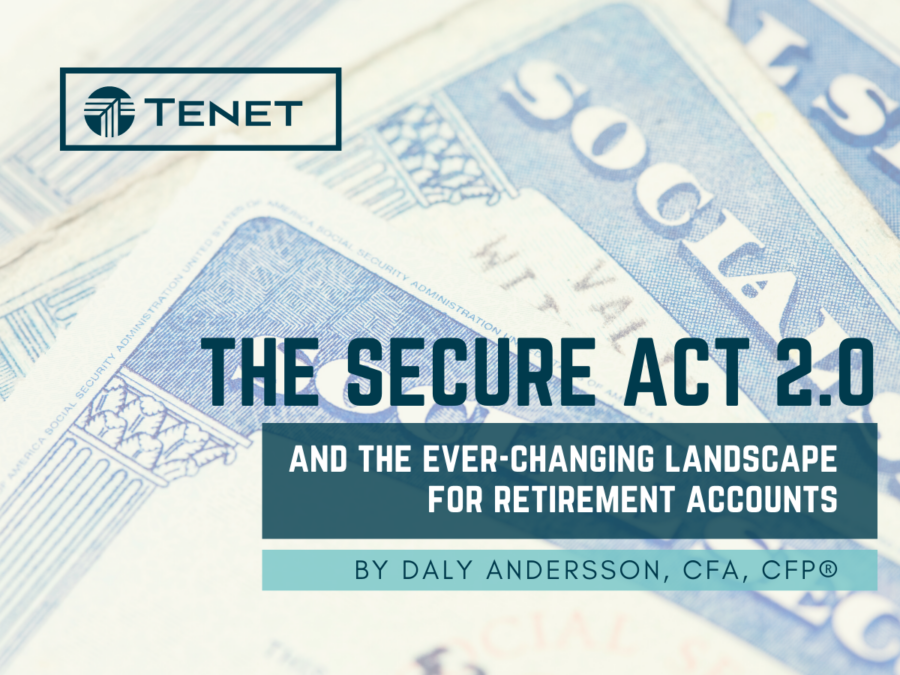Learn more about the SECURE Act 2.0 and the ever-changing landscape for retirement accounts.
At the tail-end of 2022, Congress passed new legislation called SECURE 2.0, which includes several important changes affecting current and future retirees. We have highlighted below some of the top changes and how they may impact your retirement goals and expectations.

#1- There is a New Age for Required Minimum Distributions or “RMD’s”
The most impactful change in SECURE Act 2.0 is changing the age at which individuals are required to take distributions from their qualified retirement plans. Starting this year, the Required Minimum Distribution age has increased from 72 to 73. In 2033, the age for Required Minimum Distributions will increase again to age 75. For most individuals, this is well past the age at which they plan to retire and begin using their qualified retirement accounts. For retirees with other resources to supplement their retirement needs, delaying the age in which you are required to take distributions may provide some planning opportunities. Waiting the extra year may provide additional time for tax-deferred growth, an additional year of lower taxable income, and an opportunity to take advantage of Roth conversions.
On the other hand, condensing your Required Minimum Distributions over fewer years may mean that you will have larger distributions once you do begin taking them, leading to potentially larger tax bills in retirement. Larger balances in pre-tax retirement accounts relative to other assets like Roth or taxable investment accounts may also mean more taxes are passed along to heirs. The original SECURE Act of 2019 modified the distribution options available for many beneficiaries receiving inheritance from qualified retirement accounts. In this change, most non-spouse beneficiaries are required to withdraw the balance of their Inherited IRA over a 10-Year period.
Take Home Message – If you are turning 72 in 2023, your Required Minimum Distributions begin next year in 2024.
#2- Qualified Charitable Distribution (QCDs) Age Remains Unchanged at 70.5
The age at which you are eligible to begin making charitable gifts through your IRA remains 70.5. One notable change beginning this year is that individuals may choose to make a one-time gift to a Charitable Remainder Trust or Charitable Gift Annuity. The one-time gift maximum is $50,000 adjusted annually for inflation. There are many nuances to this rule. First, the trust or gift annuity many only be funded by Qualified Charitable Distributions. No other funding sources to the gift vehicle are eligible. Second, the only individuals eligible to receive income from the gift annuity or Charitable Remainder Trust are the donor or the donor’s spouse.
Qualified Charitable Distribution (QCD) Enhancement. Starting in 2024, annual limit for QCDs, currently $100,000, will be indexed to inflation.
#3- Changes to Retirement “Catch-Up” Contributions
“Catch-Up” contributions are an additional contribution amount that individuals 50 and older are able to defer into their retirement plans. The idea is to allow individuals who are nearing retirement an opportunity to increase their retirement savings. Currently, the “Catch-Up” contribution to 401K and 403B plans is $7,500. There are two meaningful changes in the SECURE 2.0 Act that affect the “Catch- Up” Contributions for employer retirement plans.
- Effective in 2024, individuals who earn more than $145,000 in wages will be required to make their “Catch-Up” contributions to the Roth feature in their qualified retirement plan. They will not be eligible to defer their “Catch-Up” contribution pre-tax.
- Starting in 2025, individuals aged 60 through 63 will be eligible to make higher ‘catch-up’ contributions to their 401K or 403B retirement accounts. In addition to the normal employee contribution limit, participants will be able to make enhanced “catch-up” contributions of up to $10,000 annually (or equal to 150% of regular catch-up contribution limit).
#4- Rollovers from 529 College Savings Accounts to Roth IRAs
Good news for families that have excess funds in 529 College Savings Plans. Starting in 2024, money in 529 College Savings Plans may be rolled over into a Roth IRA for the account beneficiary. There are some notable nuances when it comes to how these rollovers will work. First, the 529 plan must be open for a minimum of 15 years. Important note: it is likely that changing the beneficiary of a 529 plan will re-start that 15-year clock. Second, there is a lifetime limit of $35,000 that may be rolled over from the plan to the beneficiary’s Roth IRA. Third, the beneficiary is still subject to the annual Roth contribution limits. This means that the account owner may roll over up to $6,500 (or the contribution limit for the year) into a Roth IRA for the beneficiary each year until they reach the $35,000 lifetime maximum. Finally, contributions or earnings on contributions made in the preceding five years cannot be rolled over.
#5- Other Changes to Qualified Retirement Plans
Emergency Savings attached to Retirement Accounts
Beginning in 2024, there will be an Emergency Savings Account feature attached to employer sponsored retirement plans. Non- highly-compensated employees will be eligible to defer their retirement contributions into the emergency savings account until the balance reaches $2,500 (or lower as stipulated by the employer). Once the account balance exceeds the stated amount, the contributions will be allocated to the qualified retirement plan. The deferral to the Emergency Savings Account is treated as an employee contribution and eligible to receive the employer match into the qualified retirement plan. The idea behind this new feature is to help American families better prepare for financial emergencies that may arise. By setting aside funds to cover such emergencies, families may have more financial stability.
Student Loan Repayments
Individuals who are making payments on qualified student loans and not saving in their employer retirement plans will no longer sacrifice their employer’s matching contributions. Eligible payments towards student loans will be counted just like employee retirement plan deferrals for the purpose of the employer match.
Auto-Enrollment into Qualified Retirement Plans
Beginning in 2025, 401(K) and 403(B) plans will be required to automatically enroll participants one they are eligible. Employees themselves may opt out of participating. Participants who are automatically enrolled will be elected to defer at least 3% of their income to the retirement plan.
Matching is now allowed for Roth 401(k)/403(b)/457(b) plans
Current law only permits employer matching into the pre-tax bucket of an employee 401(k). The new legislation permits employers to offer Roth matching as well, which goes in after-tax yet has the opportunity to grow tax-free.
Effective starting 2024, RMDs from Roth 401(k) and Roth 403(b) plans are eliminated.
The above points are only a subset of the multiple changes and rules released with SECURE 2.0. Our team at Tenet can help personalize your planning specifically to your situation and needs. As always, please do not hesitate to reach out to us with questions or as you need assistance, and we also highly recommend consulting with your tax advisor before proceeding with any strategies.
Sources
H.R.2954 – Securing a Strong Retirement Act of 2021
SECURE Act 2.0: Later RMDs, 529-To-Roth Rollovers, And Other Tax Planning Opportunities
The information provided in this communication was sourced by Tenet Wealth Partners through public information and public channels and is in no way proprietary to Tenet Wealth Partners, nor is the information provided Tenet Wealth Partner's position, recommendation or investment advice. This material is provided for informational/educational purposes only. This material is not intended to constitute legal, tax, investment or financial advice. Registered Representatives of Sanctuary Securities Inc. and Investment Advisor Representatives of Sanctuary Advisors, LLC. Securities offered through Sanctuary Securities, Inc., Member FINRA, SIPC. Advisory services offered through Sanctuary Advisors, LLC., an SEC Registered Investment Advisor. Tenet Wealth Partners is a DBA of Sanctuary Securities, Inc. and Sanctuary Advisors, LLC.

